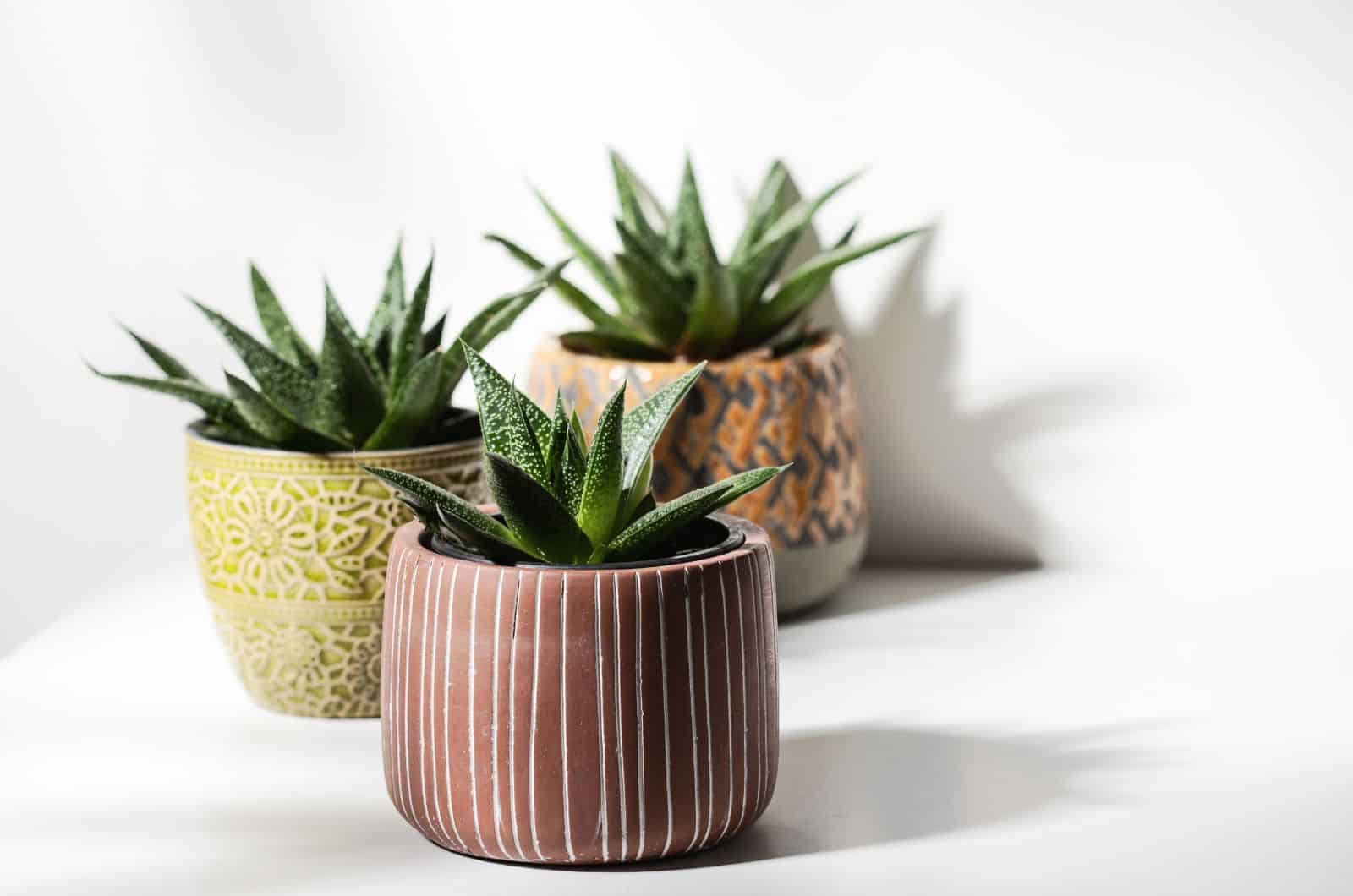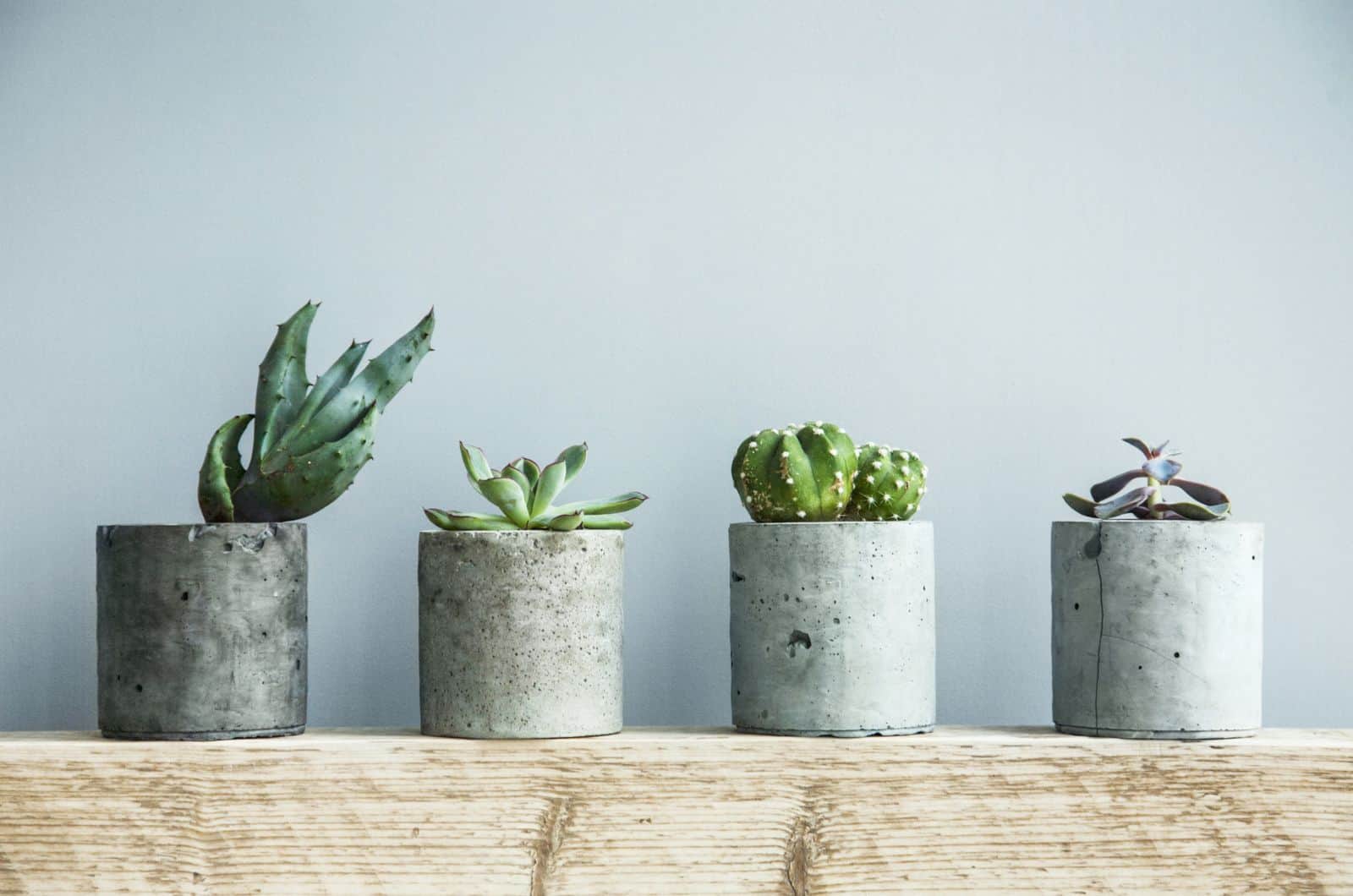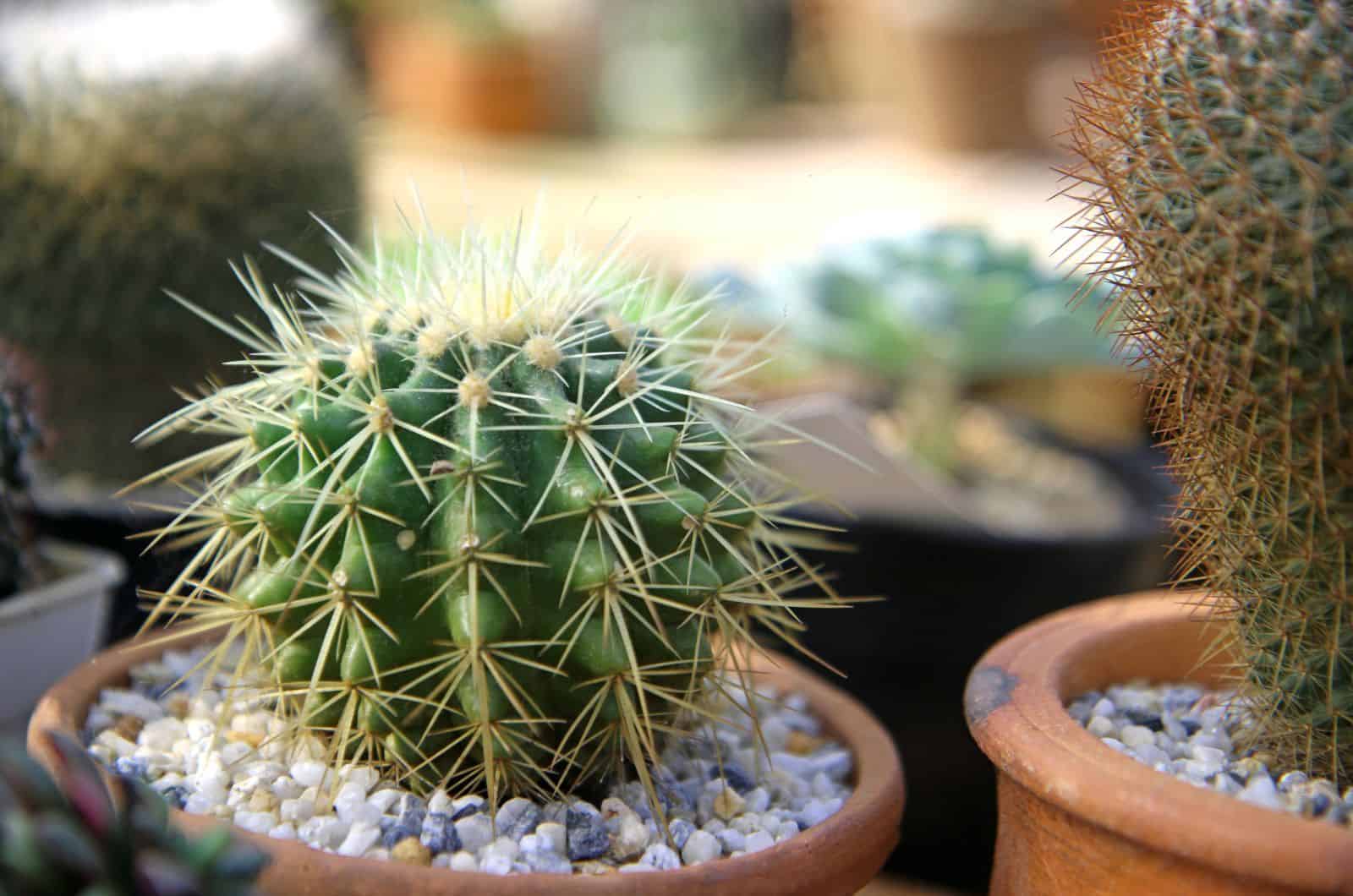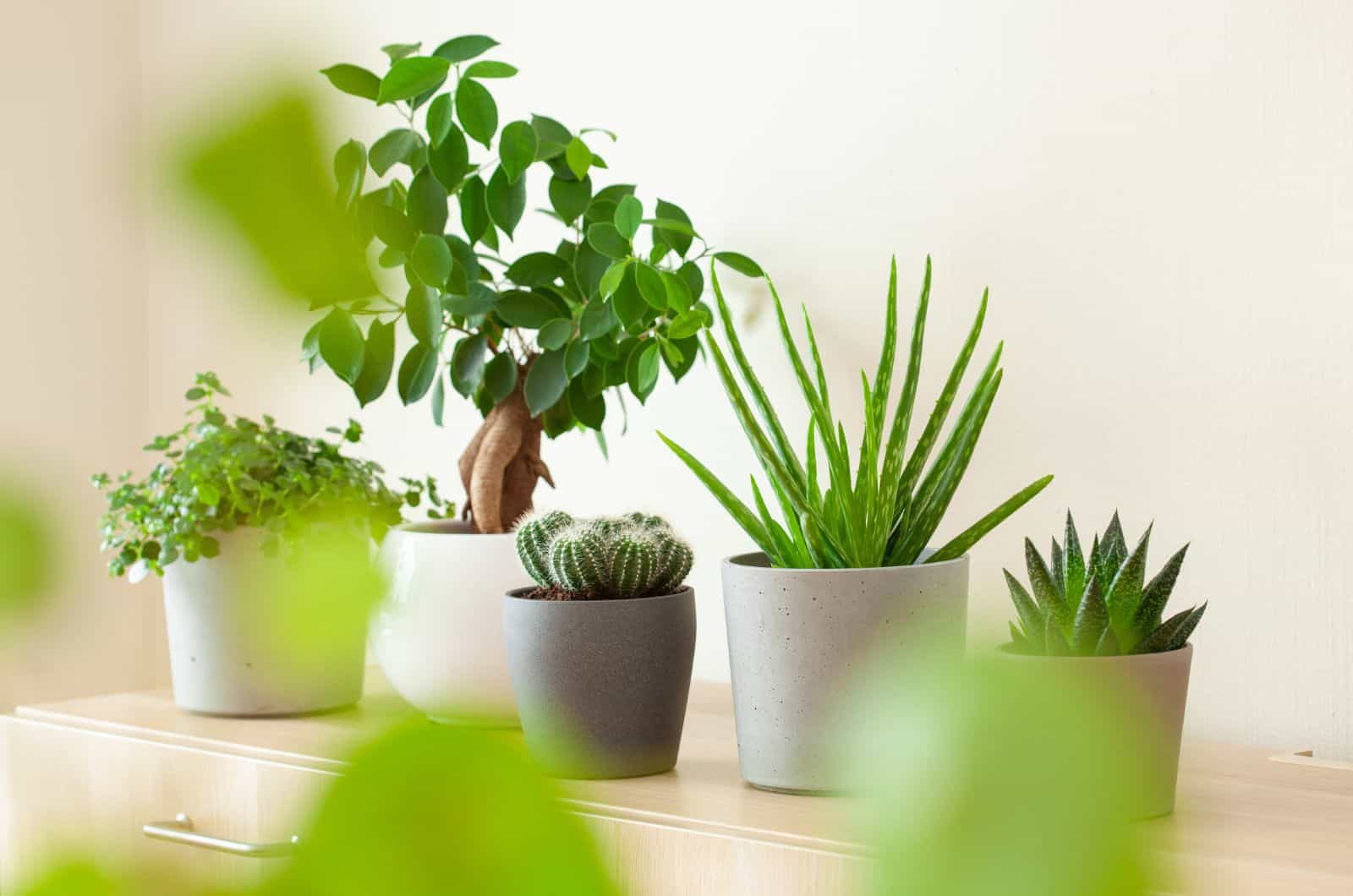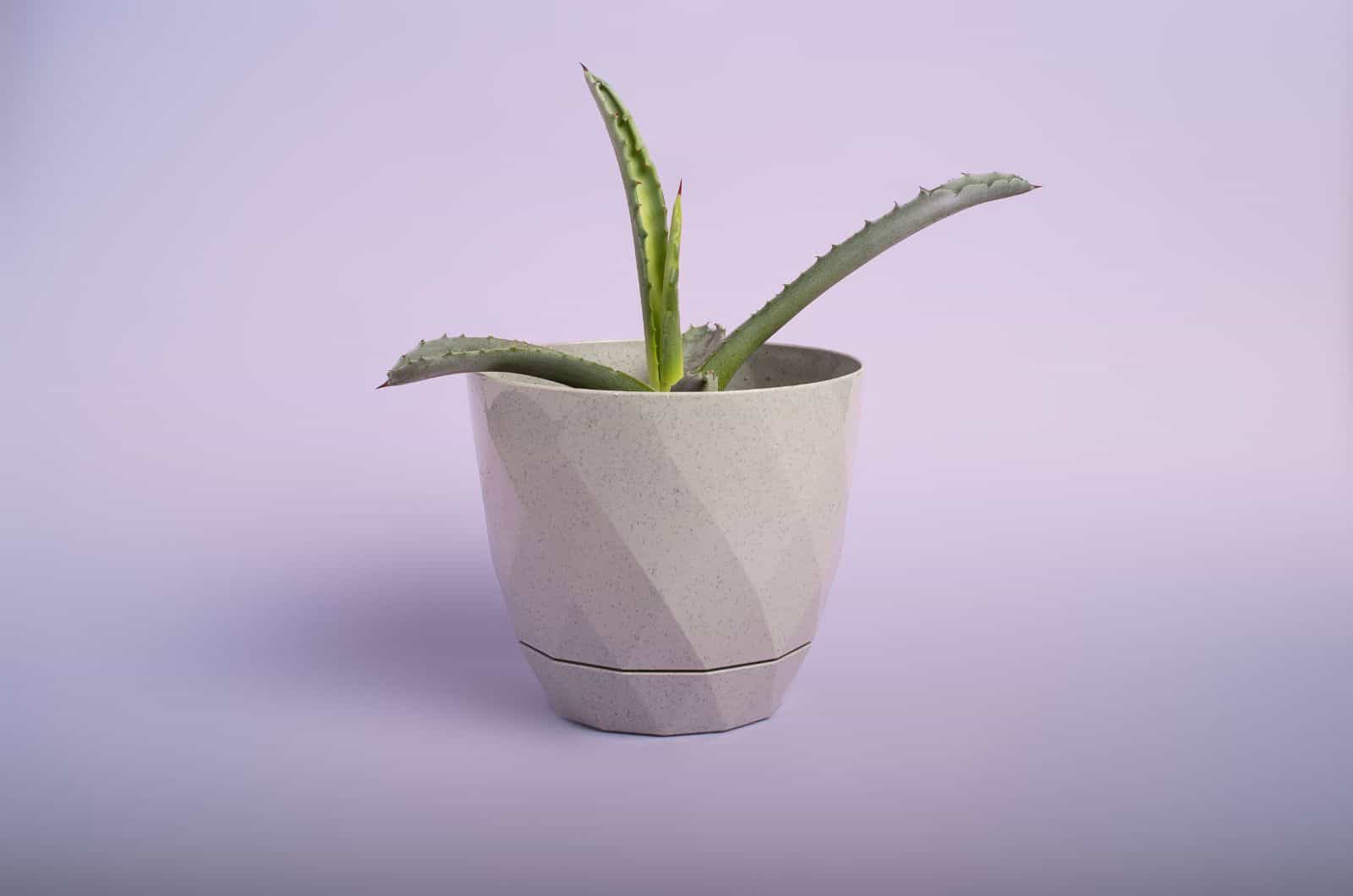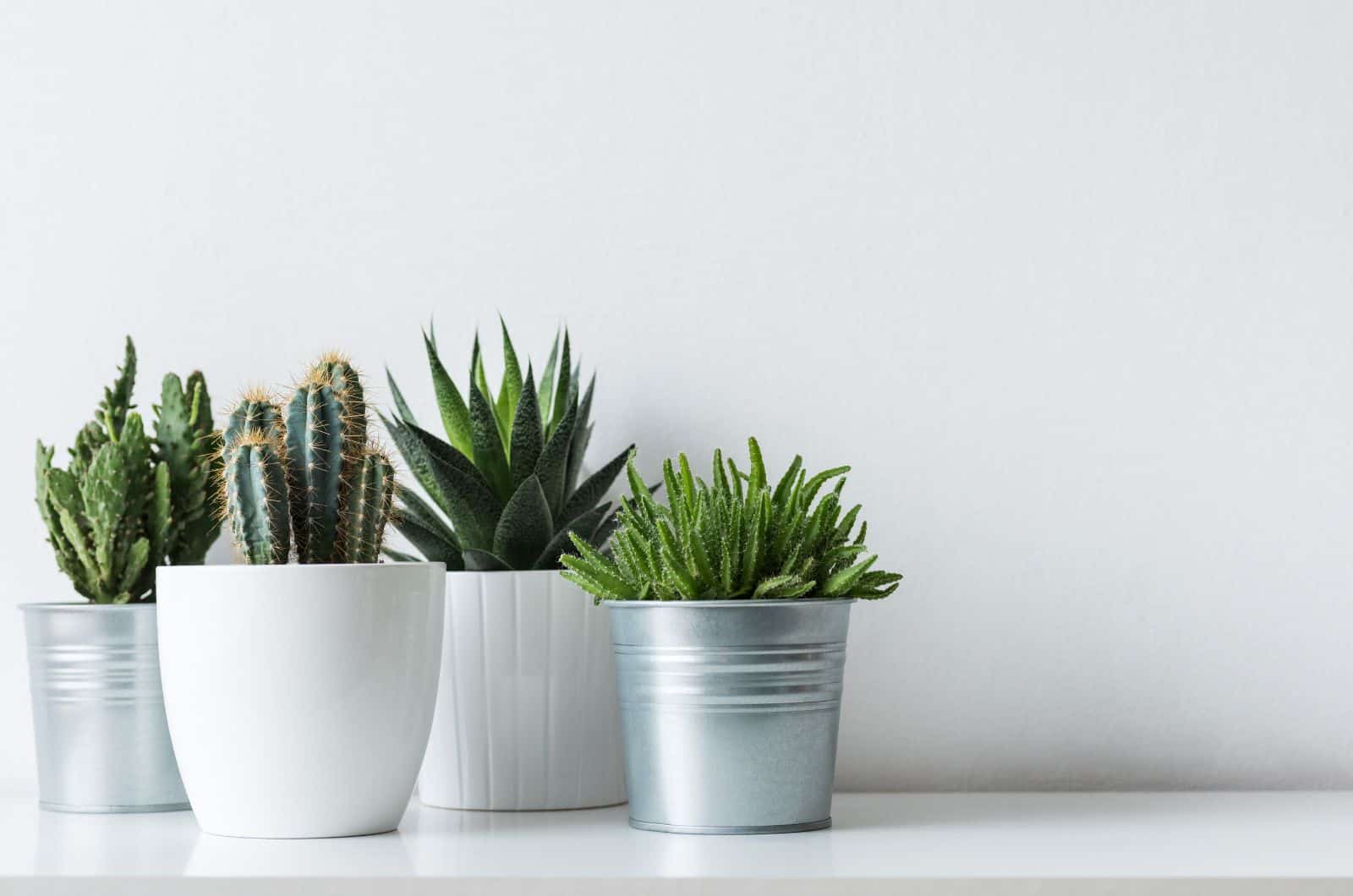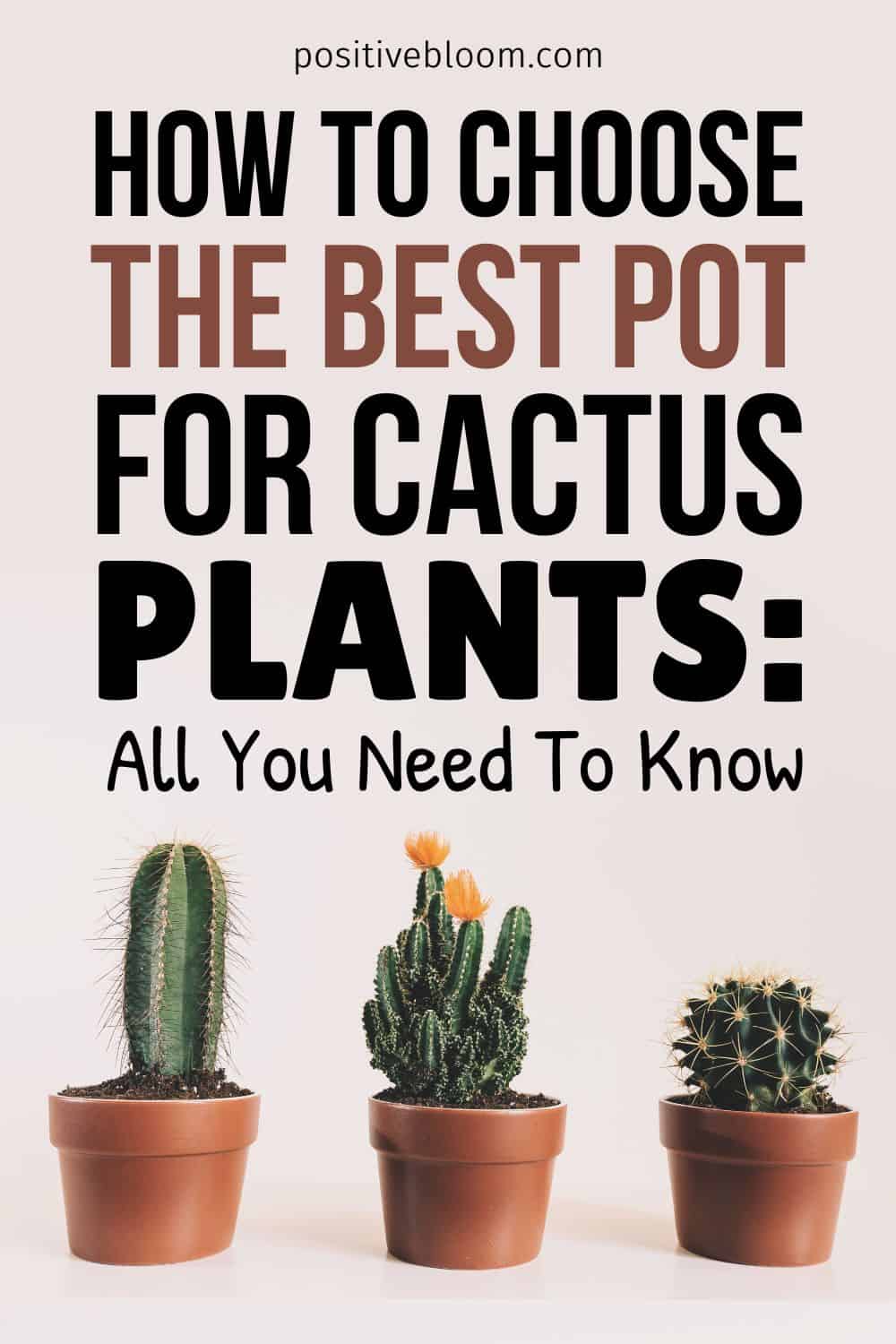Cacti plants are so low-maintenance and hardy that it seems like they could grow anywhere!
Unfortunately, that isn’t actually the case. Though cacti don’t need frequent watering or fertilizers, and can even grow in the scorching sun, you will still have to provide them with comfortable space to grow and develop.
Finding the best pot for cactus plants is not as simple as you may think; you have to take into account pot material, pot size, temperature, and humidity levels in your house! It’s not all about aesthetics.
Luckily, there are plenty of beautiful cactus pots that can fit perfectly in any home decor.
So, without further adieu, let’s choose the best pot for your little cactus!
How To Choose The Best Pot For Cactus Plants
At the beginning of my gardening journey, I would simply buy the prettiest pot in the garden center without even thinking about the materials or the size. It wasn’t long before all my cacti plants started turning black!
It turned out that I had been overwatering my cacti plants, and plastic pots definitely made things worse. Most of my cacti plants got root rot, but I was able to save them!
You should definitely learn from my mistake and consider these things when choosing a pot:
• Drainage
• Pot Size
• Temperature and humidity
• Watering habits
• Pot material
• Location
Read also: The Best Pot For Monstera: 7 Tips To Help You Choose
1. Drainage
The most common issue faced by beginner gardeners is overwatering cacti plants. They already don’t need a lot of watering, but growing them in the wrong pots can make the few watering sessions they do get detrimental.
Proper drainage is crucial for keeping your cacti alive!
To provide them with good drainage, you have to grow them in pots with drainage holes in the bottom filled with well draining potting soil.
Drainage holes are useful for the removal of excess water when watering your houseplants, and soil that drains well ensures that the soil absorbs and retains enough moisture to be happy and healthy.
Pots that don’t have drainage holes in the bottom are called cachepots, and you want to avoid them!
Though if you do find a beautiful pot without drainage holes in the bottom of the pot, you can always take matters into your own hands and drill some holes — a little DIY project is always fun!
2. Pot Size
When selecting a pot for your Cactus plant, one of the most crucial factors to take into account is the pot size. There are numerous cacti plants that come in all sorts of shapes and sizes, like dwarf varieties that grow only a few inches, and larger ones that can grow to several feet in height.
Regardless of whether you are growing a small cactus or a larger variety, the main body of the cactus should be 1/4 of an inch away from the pot’s rim for optimal growth and development.
Width
Cacti are succulents, and there are plenty of beautiful succulent pots that come in all different sizes. When considering the width of your new pot, please note that you should be familiar with the species that you are growing.
Though it isn’t common, some cacti plants have roots that grow horizontally and require a shallow pot. If you grow these types of succulent plants in a deeper pot, you will notice that the tiny roots start showing on the side of the container.
In this case, you should repot the plant into a wider pot.
Choose a pot that is only 10% broader than the cactus. For example, if your plant is 5 inches wide, then the width of the right pot would be 5.5 inches.
Depth
I’m sure you only want what is best for your little succulents, and this includes providing their root system with just enough space so that they are comfortable and happy. If an indoor plant is growing in a too-small pot, it might lead to it being root-bound and suffering from stunted growth.
When you are buying the pot, please note that taller cacti plants develop deeper roots which is why you should buy a deeper pot. Shallow pots are suitable for those cacti plants that develop shallow roots.
Pot depth is one of the main reasons you should repot a plant — young and small plants are usually grown in small pots to avoid overwatering, and as they grow they will need much larger pots than their current pots.
If you see cactus roots coming out of the drainage holes or that your cactus isn’t growing at all , then it’s time for repotting.
Repot the plant in a pot 2 inches larger than the previous one, and make sure that you are using the right soil mix.
Keep taking care of your repotted cactus, and soon enough the root ball will get back to normal and continue with its main function of absorbing the nutrients necessary for growth!
3. Temperature & Humidity
Temperature is an important part of choosing the best pot for a cactus plant as it greatly affects the water requirements.
For instance, if you put your plant in a warm, dry environment with little humidity, it will dry out rapidly and need to be watered frequently. On the other hand, if the humidity is high your plant won’t require as much water because it gets it from the air.
You won’t need to water your plant as frequently if the temperature is low because the soil will take longer to dry out.
Depending on the temperature you plan to keep your plant in, you must decide between non-porous and porous pots, and we will talk about them shortly!
However, in both situations you must select a pot with drainage holes and potting soil that drains properly.
4. Watering Habits
There are two different kinds of plant lovers: those who overwater their plants and those who don’t water them enough. Regardless of which group you fall into, we have a solution for both situations!
As the Cactus is a succulent plant that prefers slightly moist to completely dry soil, you will need to water it every now and then. It’s very easy to overwater it, which causes root rot – a fungal disease that can completely destroy your plant!
Fortunately, you can place your plant in a pot that either holds moisture or dries out quickly. We call them either porous or non-porous pots.
Porous Pots
Porous containers are ideal for avoiding overwatering. There won’t be any additional moisture retention because of the numerous tiny holes in them that allow air and water to pass through. These typically come in the form of clay, concrete, or terracotta pots.
They are available in a wide variety of colors and shapes.
The majority of them are affordable, simple to find, and feature drainage holes in the bottom of the pot.
You won’t be able to see your plant’s roots in these sorts of pots, and they may leave a stain if water seeps through them because they are not waterproof.
Non-porous Pots
Non-porous pots are built of water-resistant materials and impermeable to both air and water. They include wooden, metal, fiberglass, stone, and glazed ceramic pots.
These containers are fantastic because they effectively retain moisture, which is especially important in the event that you occasionally forget to water your houseplants.
Additionally, there are loads of gorgeous, non-porous pots with drainage holes that are excellent for ornamental purposes. They are also difficult to break, which is ideal if you have children and animals running around the house.
However, these containers make it difficult to view the roots clearly. Additionally, wooden pots sometimes rot and metal ones occasionally rust, so make your choice with caution!
Non-porous plant pots aren’t great for your cactus plant because they don’t need that much moisture in the soil.
5. Pot Material
Pot material is probably one of the most important things to take into consideration when choosing the best pot for cactus plants. We already mentioned porous and non-porous pots, and we are now going to dive in deeper to the different pot materials.
There are so many materials, including ceramic, clay, terracotta, wood, plastic, and metal, so it can be difficult to choose what suits your plant best.
Let me get straight to the point — ceramic, terracotta, and glazed ceramic pots and containers are definitely the best materials for a succulent planter.
The materials that you should avoid are fiberglass, plastic, and metal.
Let’s look at these pots in more detail.
Ceramic Pots
The most attractive pots are unquestionably ceramic pots, which are available in a variety of sizes and forms, making them ideal for dwarf cacti plants. These ceramic planters are seriously heavy, and it would definitely be hard to move them.
There are two types of ceramic pots — glazed and unglazed.
Glazed ceramic pots are non-porous, and we have already discussed that you should stay aways from these types of plant containers. However, unglazed ceramic pots are porous and they are perfect for growing cacti plants, especially because they prevent the build-up of water in the soil!
However, I would not recommend putting new or young plant seedlings in a ceramic pot because they still need moisture for growth and development, especially if you are growing an outdoor plant that is being kept in the hot sun.
Clay Pots
Clay pots are also known as terracotta pots, and are most commonly used when growing tall succulent plants. What’s great about these types of pots is that you can tell the moisture levels in the soil because the pots absorb moisture, which creates visible marks on the pot.
They are also porous, which makes them great for water drainage and air flow.
However, they are quite delicate and can be broken easily. If you have kids or pets running around all the time, then I would suggest you use a different pot material instead because clay can easily shatter into a million pieces.
Sometimes cactus roots can penetrate the pot’s wall and create holes, which can be very unsettling for the plant (and the soil would be literally everywhere!).
The soil can dry out quickly during summer, so you might need to water them more frequently. When transplanting a cactus during summer, make sure to water it more frequently to prevent it from drying out.
Nonetheless, clay pots are great for most houseplants, especially because they come in various shapes and with unique patterns!
Plastic Pots
Plastic cups are perhaps the most practical option because they are portable, affordable, and easily placed into whatever type of pot you desire, including clay, terracotta, or cachepots. However, because they are composed of a non-porous material that resists water evaporation, they might not be the best choice for a cactus plant.
If you decide to use plastic cups, make sure they have drainage holes in the bottom or your cactus may rot.
Plastic planters aren’t so bad. Once you water your precious cactus the water will evaporate at a much slower pace, which means that the plant will require less watering.
They are much tougher than clay pots, and plastic containers won’t break easily. However, I wouldn’t recommend buying large pots made out of plastic because they can easily be tipped over.
Metal Pots
Metal containers have become quite trendy lately, and it’s primarily because they are very durable and come in different shapes and sizes. I have a pink metal planter that creates a great pop of color in my garden!
These pots are usually used as flower pots, though you can grow all different kinds of plants in these containers.
Another great thing about these pots is that they can last a long time, just like the majority of cacti plants. They are also slow growers so you won’t have to worry about repotting. However, you might want to choose a different pot if you are growing a Moon cactus plant because they don’t last very long.
Unfortunately, there are also some disadvantages to growing plants in metallic pots. For instance, they are susceptible to rust – especially if they are made out of iron. Luckily, you can use rust-resistant materials to prevent rusting.
Metal is a great heat conductor, which means that these pots can get very hot during summer. If you keep yours on a windowsill during summer, I would suggest you use curtains to block out direct sunlight.
Your plants are also more susceptible to cold in these types of planters, so keep that in mind if you are growing an outdoor cactus plant.
Finally, make sure that they have drainage holes in the bottom because they are non-porous pots that retain moisture.
Read also: Are Moon Cacti Long-lasting? All The Moon Cactus Lifespan Info
Wooden Pots
If you want to keep in touch with nature, you should definitely consider growing your cactus in a wooden pot. These work great, especially if you are growing an outdoor cactus, because they can resist cold and retain moisture.
Pots made out of wood are particularly special because most of them are hand-made, so you can see true craftsmanship (plus, they work great with any home decor!).
As we already mentioned, these types of pots are prone to rotting, which can also affect the health of your cactus plant. Aloe and cacti are probably the most common succulents prone to overwatering, and growing them in already rotting wooden pots will do more harm than good.
Luckily, this problem can easily be fixed — all you have to do is line the inside of the planter with a plastic bag. A wooden planter’s ability to drain is also jeopardized if you put plastic bags at the bottom. Therefore, make sure to puncture the plastic lining with a few holes to allow for drainage.
I would recommend you consider bamboo trays because they look great with wooden pots!
Read also: Signs Of An Overwatered Aloe Plant And How To Fix It
Glass Pots
Even though glass containers are great for terrariums, they won’t help your cacti flourish if you grow them for a long period of time. Glass pots are truly breathtaking, and their light weight makes the whole process of redecorating a lot easier. However, they are not great for cacti plants.
First of all, they don’t have drainage holes in the bottom – and you can’t drill them either because it would simply break the glass. Second of all, they can easily fog up, so humidity is always increased.
As well as this, the glass can easily heat up and damage the plant’s roots, so avoid keeping your cactus in full sun exposure if you choose to grow it in a glass pot.
Concrete Pots
Concrete pots are perfect if you are growing your cactus plant outdoors. These unique-looking pots can withstand severe weather conditions and they are pretty heavy, so it’s unlikely that they will be tipped over by a strong wind.
Concrete can be manufactured in various shapes, so you can find one that suits your garden’s aesthetic perfectly. Of course, there are also colorful ones that will definitely make your garden look more cheerful!
The level of porosity depends on the type of concrete pot in question — you should get porous ones that allow air and water flow. This way you won’t have to worry about root rot and water drainage.
Please note that concrete generates lime, which reduces the pH of water. The health of your cactus may be affected by this. Simply water it frequently to remove the extra lime.
5. Location
When it comes to the location, we usually think of growing indoors vs outdoors. Everything you need to know about the best places to grow a cactus plant indoors and cactus plant care can be found down below!
If you live in an area with lots of rain and heavy winds, I would suggest you keep your cacti plants indoors. These plants are generally easy to take care of, they just need lots of sunlight!
However, if you decide to keep your cactus outdoors even though you live in an area with frequent rain, I would recommend you to definitely choose a pot with drainage holes in the bottom — you should even consider adding additional ones to improve drainage (avoid cachepots at all cost!).
To help with drainage during periods of intense rain, you might also want to think about adding perlite to the potting soil.
On the contrary, if you live in a warm and sunny area with less frequent rainfall, I would suggest you put your cactus in a non-porous pot to help it retain moisture. Put your plant in a sturdy, weather-resistant container if you live in a windy place because others, like plastic ones, can easily be blown away — concrete pots are the best for resisting the wind!
Brief Cactus Plant Care Guide
We have already mentioned that cacti plants are easy to take care of, but they still require some maintenance. Even though you won’t have to worry about buying fancy fertilizers, you still have to provide them with good soil and bright indirect sunlight.
Read on to find out all the details!
Soil Requirements
Cactus plants prefer slightly more acidic to neutral soil that drains well and is aerated. Although they appear to grow best in sandy soil, they are not very particular about the soil type.
The trick is to incorporate tiny pebbles or stones into the potting soil in an effort to mimic their natural environment.
To help you grow this tiny green cactus, you can always purchase cactus potting soil or succulent potting soil.
Temperature Requirements
When you think about the natural environment of cacti plants, the dry and scorchingly hot desert probably comes to your mind. Well, you might not need to keep temperatures quite that hot, but beware that cacti absolutely love warmth!
These plants will do just fine at normal room temperature, though their preferred range is from 70 to 95 degrees Fahrenheit. During winter they will go dormant and require cooler temperatures, from 55 to 60 degrees Fahrenheit.
Just remember that cacti plants are not cold-hardy and they cannot withstand freezing temperatures (except for a few rare cactus species).
Watering Requirements
If you are a busy bee that tends to forget about a watering session or two, then cactus plants are perfect for you because they can survive without water for a long period of time (just remember that they have adapted to live in completely dry desert environments!).
However, these plants can easily get overwatered if you tend to water your plants more frequently.
If your cactus starts to turn black, you should check the soil right away because overwatering is the prime suspect.
This problem may result in the development of root rot, a fatal fungal disease that will entirely destroy your plant.
The best approach is to examine the soil before watering. When you water these plants, always be sure to water them well so that the water drains out of the holes in the bottom. The soil should be allowed to totally dry out between waterings.
During the summer, I water my cacti plants once a week, but I always make sure to first check to see if the soil is dry. In the fall and winter, you can skip watering your plant.
Light Requirements
These plants can grow in various light conditions; however, they thrive best in bright indirect sunlight. They can be exposed to direct sunlight, but most young plants can easily get sunburned.
Even mature plants are prone to sunburn if you keep them exposed to the hot sun for more than a couple of hours throughout the day.
Generally speaking, they should receive at least 4 hours of light during the day, and a maximum of 14 hours per day.
Humidity Requirements
Cacti plants can flourish in relative humidity levels and withstand low humidity conditions, so there is no bother about humidity requirements.
You may boost humidity by misting your plants on a regular basis. Your plants will receive adequate moisture from misting without the soil becoming soggy. However, please ensure that the soil is completely dry before misting.
Fertilizing Requirements
There is no need to purchase additional cactus fertilizer if you are already using a typical cactus potting mix because it should already contain all the nutrients needed for healthy growth and development.
During the growing season you can use organic fertilizer once a month to promote growth and development. Please take care not to overfertilize the plant, though, as these chemicals can readily accumulate in the soil and obstruct the roots’ ability to effectively absorb water and nutrients.
Repotting
Cacti plants are well known for being slow-growers, though there are some fast-growing cactus varieties that should be repotted more frequently.
If you do decide to repot this plant, be sure to use the right potting soil and a somewhat larger container (if the plant has outgrown its current pot).
Just wait until the soil is totally dry, then carefully remove the cactus plant from the pot and shake off any extra soil. The new pot needs to have drainage holes in the bottom so that extra water can drain out.
Final Word
Picking the best pot for cactus plants is not an easy job! You have to keep in mind the pot material and size, as well as the place that you are planning to keep your new cactus.
You should not buy a pot just because it’s pretty, though there are plenty of pots with unique designs, so anyone can find the one that suits their style!
Make sure that it suits your cactus plant, and don’t forget to take good care of it. If you tend to overwater your plants, then consider buying a porous pot. If you want to grow an outdoor cactus, then consider a concrete pot as they are heavy and won’t get blown away by the wind.
Read our article thoroughly and make smart choices — trust me, your plant is going to love it!
Until next time!
Like this post? Share or pin it for later!

